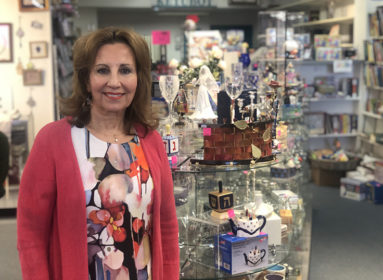
The artist's rendering of Cantor Joseph Ness
By Cindy Mindell ~
WEST HARTFORD – Award-winning political cartoonist Steven Brodner is renowned for his work in national publications like The New Yorker, Mother Jones, and Rolling Stone. It’s not every day that he is commissioned to draw a non-political figure. But when Hartford-based art director Elisa Wagner saw Brodner plying his craft in a PBS documentary film on Cab Calloway, she thought he’d be the perfect artist to render Cantor Joseph Ness of Beth El Temple, who celebrates his 20th anniversary at the West Hartford synagogue in June. Beth El will host a musical tribute to Ness featuring the Grammy Award winning ensemble Pacifica Quartet on Thursday evening, June 14.
Last month, the three met in a New York restaurant and Brodner agreed to capture Ness on paper. He spoke with the Ledger about his work and how a political cartoonist sees the world.
Q: How did you get enough of a sense of Cantor Ness to portray his character?
A: The meeting was very important to get a sense of his demeanor, his style, the way he speaks, where his interests lie, his likes and dislikes. One on one, we hit it off and I was happy to be doing the project. I watched him on DVD, looked at a lot of photos. My original approach was to draw him as a performer singing and being involved in his creative act, like the drawing I did of Cab Calloway. But the event committee decided that he needed to be holding a Torah and wearing the garments that he would wear in synagogue when performing a service, so I changed the approach. We discussed what would be written on the Torah and came up with “Sing to the Lord.”
It was a nice collaboration. I’m a political cartoonist, so this project was off the beaten path for me. It’s a different experience to be drawing something that’s positive, celebrating somebody and not making fun of somebody.
Q: Did you already know how to render Hebrew letters?
A: I got a lot of guidance from people who really knew. In order to get the letters just right, I needed to consult a traditional Hebrew alphabet and get the correct shapes of the letters. It was actually more of a challenge for me than drawing a picture. I have used Hebrew characters in the past, in the context of some policy discussion, but the work I do is mostly secular.
Growing up in a Jewish family in New York, I’ve always been very culturally Jewish. I had some religious training when I was very young but really was never attracted to being observantly Jewish. I’m a very secular person though I have a strong Jewish connection. I feel that there’s a fabulous tradition of open-mindedness and free speech and the ability for all shades and permutations to be permitted within the overall framework of what we call “Jewishness.”
Q: How you did you decide to use your artistic talents to comment on the political scene?
A: I always was a political cartoonist. I came of age in the ‘60s, when everything was highly politicized. Your ideas about civil rights, the Vietnam war, sexuality – everything was a movement and you marinated in political activism and there was a great deal of it in the media and literature, music, arts, movies. So that’s where it all comes from. I was always a political junkie and paid attention to politics. There was a big riot at the Democratic Convention in ‘68, the same year Bobby Kennedy was assassinated. It was impossible to be alive at that time and not be very politically aware. There weren’t many places to escape the media and what was happening, whereas today, a young person can spend all day long looking at media and never hear a peep about what’s really going on. There’s no connection to anything affecting other human beings or even themselves.
One way to keep people complacent is to ploy them with fantasy; media is always a drug. Awareness is necessary and I don’t know what will bring us back.
Capitalism is just one big market-research experiment: if one company gets a result, the next one creates a product to sharpen that result, to guide the missile more precisely. Google tells companies that it can find the people they want to reach, by invading their privacy just a little more.
We’re at the beginning of this process, where companies can chop their data finer and get up in your business so that you can be sold to all the time. It all happens with our permission and it’s all in our control, but we’re all seduced by the media and technology.
Q: We’re fortunate in this time and place that political cartoonists and other social commentators have a right to free expression. Have you dealt with censorship or other obstacles to speaking out?
A: We’ve had periods of censorship in this country, including after September 11. I’ve been doing images for the last 20 years for the New Yorker, Mother Jones, The Nation – and it was very hard to make a strong commentary about the Bush Administration because there was self-censorship in the media. The cumulative power of mainstream media is much greater than those smaller political journals, so most people in the country were treated to the war whoop and to the notion of war as a default mechanism to solving problems. It’s been a very self-destructive thing: so many people have died, and there has been no money in the economy for things we need, like education and repairing our bridges.
Q: Do you ever get depressed dealing with the negative aspects of politics?
A: That never depresses me because I get much more depressed reading the newspaper and seeing all the things that need commentary. If you’re a political cartoonist or an informed person reading the news, you realize that the only hope we have as a society or species is that we wake up and apply ourselves to taking action to correct long term things that are self-destructive to a suicidal extent. The real impulse I get from that awareness is to be a better political cartoonist, pointing out what’s going wrong. It’s a nice break when I’m not doing that, but the work doesn’t depress me; reading a daily succession of articles that demonstrates that we don’t know what we’re doing to ourselves as a species is more upsetting. Hopefully, some of my drawings have part of the truth.
To see more work by Steve Brodner, visit his website at stevebrodner.com.
For more information on the musical tribute to Cantor Ness at Beth El, which will include a dessert reception, call (860) 233-9696 or visit www.bethelwesthartford.org.








 Southern New England Jewish Ledger
Southern New England Jewish Ledger














